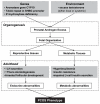Female reproductive disorders: the roles of endocrine-disrupting compounds and developmental timing
- PMID: 18929049
- PMCID: PMC4086418
- DOI: 10.1016/j.fertnstert.2008.08.067
Female reproductive disorders: the roles of endocrine-disrupting compounds and developmental timing
Abstract
Objective: To evaluate the possible role of endocrine-disrupting compounds (EDCs) on female reproductive disorders emphasizing developmental plasticity and the complexity of endocrine-dependent ontogeny of reproductive organs. Declining conception rates and the high incidence of female reproductive disruptions warrant evaluation of the impact of EDCs on female reproductive health.
Design: Publications related to the contribution of EDCs to disorders of the ovary (aneuploidy, polycystic ovary syndrome, and altered cyclicity), uterus (endometriosis, uterine fibroids, fetal growth restriction, and pregnancy loss), breast (breast cancer, reduced duration of lactation), and pubertal timing were identified, reviewed, and summarized at a workshop.
Conclusion(s): The data reviewed illustrate that EDCs contribute to numerous human female reproductive disorders and emphasize the sensitivity of early life-stage exposures. Many research gaps are identified that limit full understanding of the contribution of EDCs to female reproductive problems. Moreover, there is an urgent need to reduce the incidence of these reproductive disorders, which can be addressed by correlative studies on early life exposure and adult reproductive dysfunction together with tools to assess the specific exposures and methods to block their effects. This review of the EDC literature as it relates to female health provides an important platform on which women's health can be improved.
Figures



References
-
- Foster WG, Neal MS, Han MS, Dominguez MM. Environmental contaminants and human infertility: hypothesis or cause for concern? J Toxicol Environ Health B Crit Rev. 2008;11:162–76. - PubMed
-
- Caserta D, Maranghi L, Mantovani A, Marci R, Maranghi F, Moscarini M. Impact of endocrine disruptor chemicals in gynaecology. Hum Reprod Update. 2008;14:59–72. - PubMed
-
- Genuis SJ. Health issues and the environment-an emerging paradigm for providers of obstetrical and gynaecological health care. Hum Reprod. 2006;21:2201–8. - PubMed
-
- Giudice LC. Infertility and the environment: the medical context. Semin Reprod Med. 2006;24:129–33. - PubMed
Publication types
MeSH terms
Substances
Grants and funding
LinkOut - more resources
Full Text Sources

